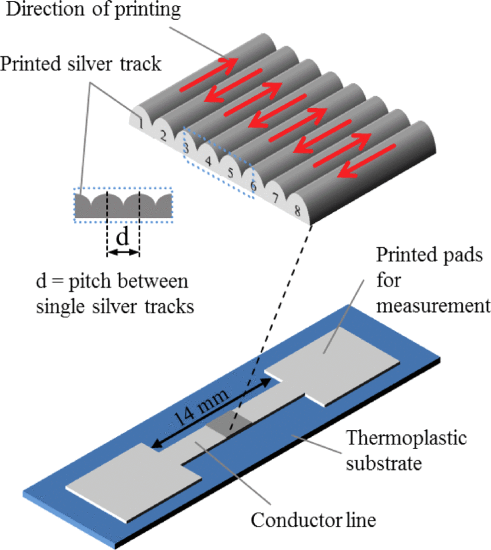Hoerber, J., Goth, C., Franke, J., Hedges, M.
2011 IEEE 13th Electronics Packaging Technology Conference, Singapore, 2011, pp. 813-818
Aerosol-Jet-Printing is an interesting approach to apply circuit tracks on three dimensional thermoplastic circuit carriers used for Molded Interconnect Devices. Therefore, possibilities for printing nanoparticle silver inks on substrate materials that meet the requirements for basic automotive applications were investigated from the view of manufacturing. Out of four different substrate thermoplastics (grades PA6.6, PA6, special PA6, and PBT/ASA) commonly used in automotive applications plate specimens with three different levels of surface quality according to molding tool manufacturing were generated. Conductor tracks printed onto the substrates consist of eight single printed lines arranged with different pitches. The setting of the pitch turns out to be an important influence on the conductivity that can be achieved at the thermoplastics substrates. Hereby the influence of irregular wetting due to the surface characteristic of the molded circuit carriers can be reduced. The investigated materials and different surface roughness show a constant performance during thermal shock for 1000 cycles in the range of -40 °C and +125 °C. While an exposure to humidity heat (85% r.h / 85 °C) for 504 h has only marginal effects on the conductivity, the adhesion of the printed structures on the thermoplastics substrates is reduced significantly during this test. Nevertheless, the highly promising results provide base for further investigations to achieve sufficient adhesion for mounting electronic components and to evaluate new inks and adaptions of the Aerosol-Jet-Process.

Hoerber, J., Goth, C., Franke, J., Hedges, M.
2011 IEEE 13th Electronics Packaging Technology Conference, Singapore, 2011, pp. 813-818
Aerosol-Jet-Printing is an interesting approach to apply circuit tracks on three dimensional thermoplastic circuit carriers used for Molded Interconnect Devices. Therefore, possibilities for printing nanoparticle silver inks on substrate materials that meet the requirements for basic automotive applications were investigated from the view of manufacturing. Out of four different substrate thermoplastics (grades PA6.6, PA6, special PA6, and PBT/ASA) commonly used in automotive applications plate specimens with three different levels of surface quality according to molding tool manufacturing were generated. Conductor tracks printed onto the substrates consist of eight single printed lines arranged with different pitches. The setting of the pitch turns out to be an important influence on the conductivity that can be achieved at the thermoplastics substrates. Hereby the influence of irregular wetting due to the surface characteristic of the molded circuit carriers can be reduced. The investigated materials and different surface roughness show a constant performance during thermal shock for 1000 cycles in the range of -40 °C and +125 °C. While an exposure to humidity heat (85% r.h / 85 °C) for 504 h has only marginal effects on the conductivity, the adhesion of the printed structures on the thermoplastics substrates is reduced significantly during this test. Nevertheless, the highly promising results provide base for further investigations to achieve sufficient adhesion for mounting electronic components and to evaluate new inks and adaptions of the Aerosol-Jet-Process.